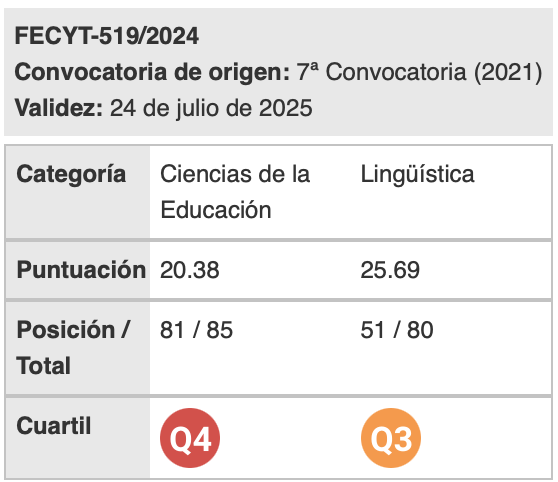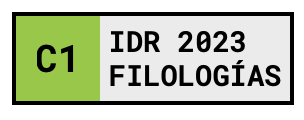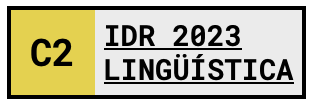Communication skills and ESP courses: a Basque experience
Keywords:
ESP, engineering, communication skills, role-play, interdisciplinary collaborationAbstract
This paper analyzes those communication skills expected of engineers, as well as their current deficiencies. Subsequently, resources required to develop technical and professional communication maturity used in English for Specific Purposes (ESP) courses are specified. In particular, oral presentations and report writing, by means of role-play and simulations, are analyzed. Also considered are other aspects directly related to the improvement of communication skills, such as metacognition and interdisciplinary collaboration (communication). Finally, a practical case is presented: an ESP course for engineers at the Industrial Technical Engineering College from Bilbao (Spain). Several examples of tasks and activities to develop such skills are presented. Moreover, studies and data regarding their opinions about the importance of all these topics in their current learning process and in the long term are presented and analyzed. The main conclusions of the study could be summarized as follows: 1. Oral presentations and report writing are highly useful to improve engineering students’ communication skills; 2. The information provided to them can be successfully applied outside academia.
Downloads
References
Benson, P. (2001). Teaching and researching autonomy in language learning. London:
Longman.
Benson, P. (2003). Learner autonomy in the classroom. In D. Nunan (Ed.),
Practical English language teaching (pp. 289-308). New York, NY: McGraw Hill. C. J. Brumfit & Johnson, K. (Eds.) (1989). The communicative approach to language
teaching. Oxford: Oxford University Press.
Burns, A. C., & Gentry, J. W. (1998). Motivating students to engage in experiential
learning: a tension-to-learn theory. Simulation and Gaming, 29, 133-151.
Castro, J., Ibañez, C. & González, J. M. (1991). Interdisciplinary collaboration. The ideal way out in LSP teaching: the fruits of the Bilbao experience. In M. McGinity, R. Alejo & S. Gómez (Eds.), Lenguas aplicadas a las ciencias y a la tecnología (pp. 38-43). Badajoz: Universidad de Extremadura y Universidade de Evora.
Coll, C. (2003). El currículo universitario en el siglo XXI. In C. Moreneo & J. L. Poso (Eds.), La universidad ante la nueva cultura educativa. Enseñar y aprender para la autonomía (pp. 271-284). Madrid: Síntesis.
Dam, L. (1995). Learner autonomy 3; from theory to classroom practice. Dublin: Authentik.
Davies, J. (2001). Communication skills: A guide for engineering and applied science students. Essex: Pearson (Prentice Hall).
Elbow, P. (1998). Writing with power: Techniques for mastering the writing process. Oxford: Oxford University Press.
Epstein, M. (1999). Teaching field-specific writing: Results of a WAC survey. Business Communication Quarterly, 62(1), 29-41.
Esposito, E. & Sigler, E. (2001). Acquiring the tools to become a successful engineer in the 21st century: Aptitudes and attitudes. In D. Weichert, B. Rauhut & R. Schmidt (Eds.), Educating the engineer for the 21st century (pp. 221- 228). The Nederlands: Kluwer Academic Publishers.
Gardner, H. (1999). Intelligence reframed; multiple intelligences for the 21st century. New York, NY: Basic Books.
González Ardeo, J. M. (2002). Project Work interdisciplinar en un curso de ESP. XI Conferencia Internacional Lingüístico Literaria (pp. 195-203). Santiago de Cuba (Cuba): Universidad de Oriente.
Goñi, J. M. (2005). El espacio europeo de educación superior, un reto para la universidad. Barcelona: Octaedro/ICE-UB.
Grünwald, N. & Krause, R. (2007). The role of the European Union in fostering entrepreneurship education. Proceedings 10th UICEE Annual Conference on Engineering Education (pp. 53-58). Bangkok (Thailand).
Hill, M. & Storey, A. (2003). SpeakEasy: online support for oral presentation skills. ELT Journal, 57(4), 370-376.
Hutchinson, T. & Sawyer-Laucanno, C. (1990). Science and technology: specific purpose language training. In D. Crookall & R. L. Oxford (Eds.), Simulation, gaming, and language learning (pp. 135-141). New York, NY: Newbury House.
Keane, A. & Gibson, I. S. (1999). Communication trends in engineering firms: implications for undergraduate engineering courses. International Journal of Engineering Education, 15(2), 115-121.
Littlewood, W. (1992). Teaching oral communication: A methodological framework. Oxford: Blackwell.
Kmiec, D. M. (2004). Teaching engineering communication: a novel vertically- integrated and discipline-conscious curriculum. http://www.stc.org/ ConfProceed/2004/PDFs/0039.pdf.
Maier, H. R. (2007). Meeting the challenges of engineering education via online roleplay simulations. Australasian Journal of Engineering Education, 13(1), 31-39.
Monge Benito, S. (2008). La escuela vasca ante el cambio tecnológico (1999-2004). Tecnologías de la información y la comunicación en la enseñanza. Leioa, Bizkaia: Servicio Editorial UPV-EHU.
Mora Ruiz, J. G. (2003). Competencias y empleo de los jóvenes graduados universitarios. Revista de Educación, 330, 157-170.
Prince, R. (2006). Teaching engineering ethics using role-playing in a culturally diverse student group. Science and Engineering Ethics, 12(2), 321-326.
Ravensteijn, W., Graaff, E. & Kroesen, O. (2006). Engineering the future: the social necessity of communicative engineers. European Journal of Engineerng Education, 31, 63-71.
Riemer, M. J. (2007). Communication skills for the 21st century engineer. Global Journal of Engineering Education, 11(1), 89-101.
Sageev, P. & Romanowski, C. J. (2001). A message from recent engineering graduates in the workplace: results of a survey on technical communication skills. Journal of Engineering Education, 90(4), 685-92.
Sweeney, S. (1997). English for Business Communication. Cambridge: Cambridge University Press.
Tedford, J. D., Seidel, R. H. A. & Islam, M. A. (2007). Teamwork and its influence on learning in industry-based projects. Proceedings 10th UICEE Annual Conference on Engineering Education (pp. 203-206). Bangkok (Thailand).
Trebbi, T. (2003). Curriculum development and learner autonomy in the foreign language classroom: constraints and possibilities. In D. Little, J. Ridley & E. Ushioda (Eds.), Learner autonomy in the foreign language classroom: Teacher, learner and assessment (pp. 61-78). Dublin: Authentik.
van Esch, K. & St.John, O. (2003). A framework for freedom: Learner autonomy in foreign language teacher education. Frankfurt: Peter Lang.
Wilder, C. & Rotondo, J. (2002). Point, Click & Wow! A quick guide to brilliant laptop presentations. Hoboken, NJ: Jossey-Bass.
Downloads
Published
How to Cite
Issue
Section
License
Authors who publish with this journal agree to the following terms:
- Authors retain copyright and grant the journal right of first publication with the work simultaneously licensed under a Creative Commons Attribution License that allows others to share the work with an acknowledgement of the work's authorship and initial publication in this journal.
- Authors are able to enter into separate, additional contractual arrangements for the non-exclusive distribution of the journal's published version of the work (e.g., post it to an institutional repository or publish it in a book), with an acknowledgement of its initial publication in this journal.
- Authors are permitted and encouraged to post their work online (e.g., in institutional repositories or on their website) prior to and during the submission process, as it can lead to productive exchanges, as well as earlier and greater citation of published work (See The Effect of Open Access).

Revista de Lenguas para fines específicos is licensed under a Creative Commons Reconocimiento-NoComercial-SinObraDerivada 4.0 Internacional License.
























